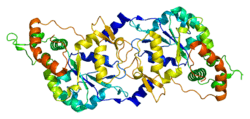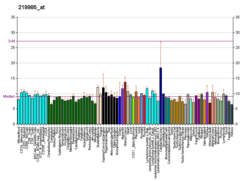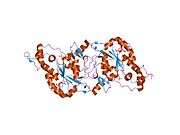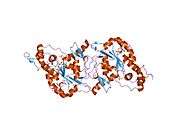HS3ST3A1
Heparan sulfate glucosamine 3-O-sulfotransferase 3A1 is an enzyme that in humans is encoded by the HS3ST3A1 gene.[5][6]
| HS3ST3A1 | |||||||||||||||||||||||||
|---|---|---|---|---|---|---|---|---|---|---|---|---|---|---|---|---|---|---|---|---|---|---|---|---|---|
 | |||||||||||||||||||||||||
| |||||||||||||||||||||||||
| Identifiers | |||||||||||||||||||||||||
| Aliases | HS3ST3A1, 30ST3A1, 3OST3A1, 3-OST-3A, heparan sulfate-glucosamine 3-sulfotransferase 3A1 | ||||||||||||||||||||||||
| External IDs | OMIM: 604057 MGI: 1333861 HomoloGene: 88735 GeneCards: HS3ST3A1 | ||||||||||||||||||||||||
| |||||||||||||||||||||||||
| |||||||||||||||||||||||||
| |||||||||||||||||||||||||
| |||||||||||||||||||||||||
| Orthologs | |||||||||||||||||||||||||
| Species | Human | Mouse | |||||||||||||||||||||||
| Entrez | |||||||||||||||||||||||||
| Ensembl | |||||||||||||||||||||||||
| UniProt | |||||||||||||||||||||||||
| RefSeq (mRNA) | |||||||||||||||||||||||||
| RefSeq (protein) | |||||||||||||||||||||||||
| Location (UCSC) | Chr 17: 13.49 – 13.6 Mb | Chr 11: 64.44 – 64.52 Mb | |||||||||||||||||||||||
| PubMed search | [3] | [4] | |||||||||||||||||||||||
| Wikidata | |||||||||||||||||||||||||
| |||||||||||||||||||||||||
Heparan sulfate biosynthetic enzymes are key components in generating myriad distinct heparan sulfate fine structures that carry out multiple biologic activities. The enzyme encoded by this gene is a member of the heparan sulfate biosynthetic enzyme family.
It is a type II integral membrane protein and possesses heparan sulfate glucosaminyl 3-O-sulfotransferase activity. The sulfotransferase domain of this enzyme is highly similar to the same domain of heparan sulfate D-glucosaminyl 3-O-sulfotransferase 3A1, and these two enzymes sulfate an identical disaccharide. This gene is widely expressed, with the most abundant expression in the liver and placenta.[6]
References
- GRCh38: Ensembl release 89: ENSG00000153976 - Ensembl, May 2017
- GRCm38: Ensembl release 89: ENSMUSG00000047759 - Ensembl, May 2017
- "Human PubMed Reference:". National Center for Biotechnology Information, U.S. National Library of Medicine.
- "Mouse PubMed Reference:". National Center for Biotechnology Information, U.S. National Library of Medicine.
- Shworak NW, Liu J, Petros LM, Zhang L, Kobayashi M, Copeland NG, Jenkins NA, Rosenberg RD (Mar 1999). "Multiple isoforms of heparan sulfate D-glucosaminyl 3-O-sulfotransferase. Isolation, characterization, and expression of human cdnas and identification of distinct genomic loci". J Biol Chem. 274 (8): 5170–84. doi:10.1074/jbc.274.8.5170. PMID 9988767.
- "Entrez Gene: HS3ST3A1 heparan sulfate (glucosamine) 3-O-sulfotransferase 3A1".
Further reading
- Razi N, Lindahl U (1995). "Biosynthesis of heparin/heparan sulfate. The D-glucosaminyl 3-O-sulfotransferase reaction: target and inhibitor saccharides". J. Biol. Chem. 270 (19): 11267–75. doi:10.1074/jbc.270.19.11267. PMID 7744762.
- Liu J, Shworak NW, Sinaÿ P, et al. (1999). "Expression of heparan sulfate D-glucosaminyl 3-O-sulfotransferase isoforms reveals novel substrate specificities". J. Biol. Chem. 274 (8): 5185–92. doi:10.1074/jbc.274.8.5185. PMID 9988768.
- Shukla D, Liu J, Blaiklock P, et al. (1999). "A novel role for 3-O-sulfated heparan sulfate in herpes simplex virus 1 entry". Cell. 99 (1): 13–22. doi:10.1016/S0092-8674(00)80058-6. PMID 10520990.
- Liu J, Shriver Z, Blaiklock P, et al. (2000). "Heparan sulfate D-glucosaminyl 3-O-sulfotransferase-3A sulfates N-unsubstituted glucosamine residues". J. Biol. Chem. 274 (53): 38155–62. doi:10.1074/jbc.274.53.38155. PMID 10608887.
- Salehi LB, Mangino M, De Serio S, et al. (2002). "Assignment of a locus for autosomal dominant idiopathic scoliosis (IS) to human chromosome 17p11". Hum. Genet. 111 (4–5): 401–4. doi:10.1007/s00439-002-0785-4. PMID 12384783.
- Strausberg RL, Feingold EA, Grouse LH, et al. (2003). "Generation and initial analysis of more than 15,000 full-length human and mouse cDNA sequences". Proc. Natl. Acad. Sci. U.S.A. 99 (26): 16899–903. doi:10.1073/pnas.242603899. PMC 139241. PMID 12477932.
- Clark HF, Gurney AL, Abaya E, et al. (2003). "The Secreted Protein Discovery Initiative (SPDI), a Large-Scale Effort to Identify Novel Human Secreted and Transmembrane Proteins: A Bioinformatics Assessment". Genome Res. 13 (10): 2265–70. doi:10.1101/gr.1293003. PMC 403697. PMID 12975309.
- Moon AF, Edavettal SC, Krahn JM, et al. (2004). "Structural analysis of the sulfotransferase (3-o-sulfotransferase isoform 3) involved in the biosynthesis of an entry receptor for herpes simplex virus 1". J. Biol. Chem. 279 (43): 45185–93. doi:10.1074/jbc.M405013200. PMC 4114238. PMID 15304505.
- Gerhard DS, Wagner L, Feingold EA, et al. (2004). "The Status, Quality, and Expansion of the NIH Full-Length cDNA Project: The Mammalian Gene Collection (MGC)". Genome Res. 14 (10B): 2121–7. doi:10.1101/gr.2596504. PMC 528928. PMID 15489334.






